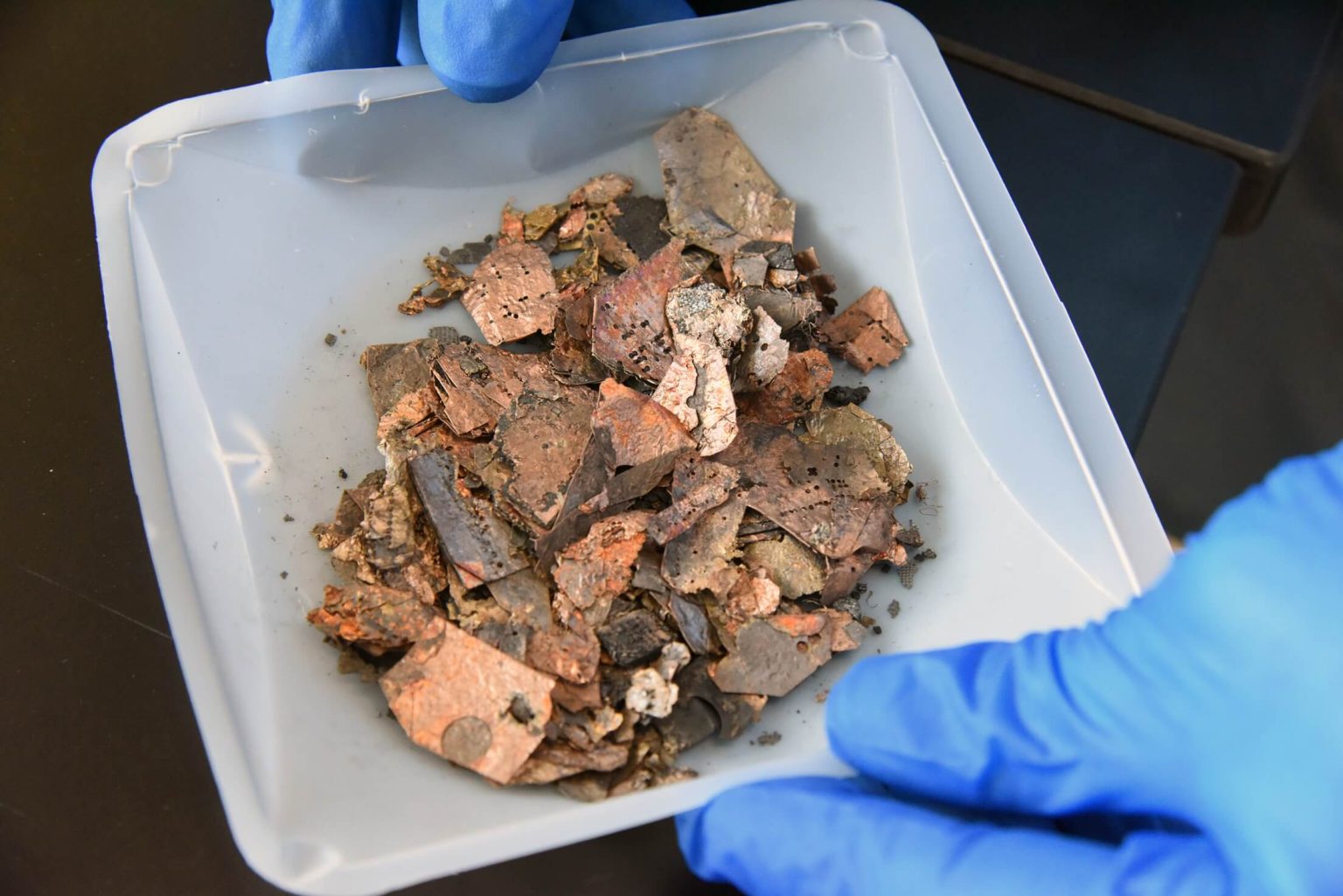As they discard their cellphones, Americans are throwing away nearly $200 million in unrecovered gold every year, according to the U.S. Environmental Protection Agency. The problem until now has been a lack of affordable or environmentally friendly recycling options.
An alternative, less toxic process developed at Idaho National Laboratory may offer a way to affordably recover precious metals from electronic devices, according to a recently published analysis.
In the journal Waste Management, INL researchers Luis Diaz-Aldana and Tedd Lister make a case that a process called Electrochemically Recycling Electronic Constituents of Value (E-RECOV) offers an economically competitive alternative to traditional smelting processes.
The paper, published online Dec. 8, 2017, says that for every dollar of capital investment, E-RECOV has the potential to process 2.9 kilograms of e-waste. Black copper smelting, a process used now, is capable of processing only 1.3 kg for every dollar of capital spent, the paper said.
The research was supported by the Critical Materials Institute (CMI), an Energy Innovation Hub funded by the U.S. Department of Energy Office of Energy Efficiency and Renewable Energy’s Advanced Manufacturing Office.
“Lower capital investment, waste generation and simplicity make the (E-RECOV) process a viable alternative for the processing of e-waste in the United States,” the paper said.
E-waste — discarded cellphones, laptops, PCs and tablets — accounts for 2 percent of the trash in America’s landfills, but equals 70 percent of the nation’s overall toxic waste, according to Camston Wrather, a San Diego-based company that specializes in sustainable resource recovery services. EPA reports approximately 350,000 mobile phones are disposed of each day. That adds up to more than 127 million phones every year and roughly $150 million in unrecovered gold (based on a late January 2018 spot gold price of $1,352.68 per troy ounce).
The E-RECOV technology incorporates an electrochemical cell to dissolve metals from electronic devices. These include precious metals — gold, silver, palladium — as well as copper, tin, zinc, lead, nickel and rare-earth elements.
Smelters rely on fossil fuels for their furnaces, while the E-RECOV process runs on electricity, which can be supplied from wind, solar, nuclear, hydro and/or geothermal sources. The main issue with hydrometallurgical processing has been the extensive amount of chemicals needed and the proportional amount of waste that must be processed.
E-RECOV significantly reduces chemical consumption by regenerating the oxidant used to extract more than 90 percent of the metal content (copper, zinc, tin and nickel), making the process very inexpensive and almost waste free. After that, the metals with high value (gold, silver and palladium) can be extracted more efficiently with less chemical consumption. Because the process uses fewer chemicals and thus avoids costs associated with disposing of them, it can compete economically with current practices, the paper said.
It is also safer and more environmentally friendly than sending electronic devices to landfills, where they may contaminate groundwater, or abroad where waste disposal standards can be lax to nonexistent.
The challenge is scaling research up, from the lab to a pilot project, then to the commercial level, Lister said. And the development of an effective collection system would be necessary to assure a full advantage of the recoverable value of the e-waste.

While there are immense opportunities for a sustainable recycling technology in the United States — the harmful dioxins produced by smelting make it unlikely it will ever be allowed domestically — a 2016 report from EPA said the majority of e-waste is still retained by end consumers and/or disposed of in landfills. Electronics submitted for recycling are handled one of two ways. They are exported to Europe or Canada for smelting — the only smelter in North America is the Glencore Horne Smelter in northern Quebec — or sent to China to be disassembled.
“There is an awful lot exported,” Lister said. “Just redirecting that to domestic recovery would be huge. We have estimated that there is up to $25,000 worth of metal per ton of e-waste. Gold mines typically have an ore grade of one or two grams per ton of material. Mobile electronics e-waste has up to 800 grams per ton by our analysis.”
When comparing the economic merits of an experimental process to one that already exists, special considerations must be made. In early-stage research, there is a high degree of uncertainty, but techno-economic assessments (TEA) help inform performance targets and identify critical processes and/or operations, Diaz-Aldana said.
Using TEA, a similar cumulative cash flow was observed for both routes. Despite 18.4 percent higher revenue for the smelting process, the E-RECOV process enjoyed a 30 percent lower operational cost, and lower capital costs contributed to an advantage as well. Projecting operational margin profiles — the ratio of operational income to total revenue — over 20 years, the research showed 21 percent higher profit for E-RECOV.
“Based on these two profitability figures of merit, it is possible to conclude that the (E-RECOV) process is a more favorable alternative for the processing of e-waste and the recovery of value and critical materials,” Diaz-Aldana wrote.
Lister and Diaz-Aldana were recognized in 2016 for E-RECOV, which they developed for INL and CMI. Honors included a 2016 TechConnect National Innovation Award, a Federal Laboratory Consortium Far West award and designation as an Idaho Innovation Award Early Stage Technology of the Year finalist.





